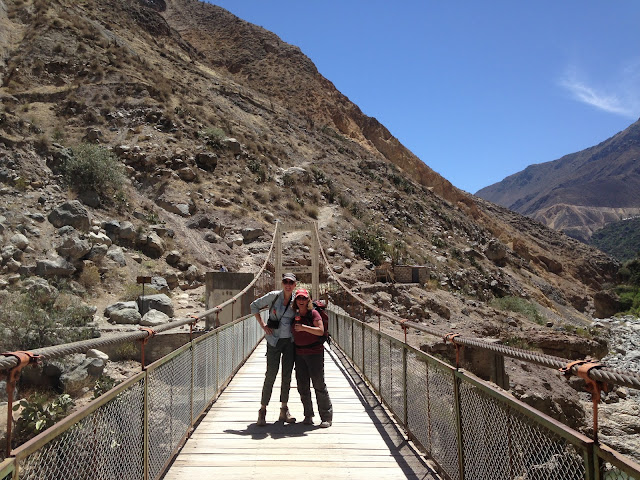*Named in loving remembrance of a drink EJ had while in Rurrenabaque
Maggie here.
After getting sucked into jungle life for longer than anticipated, we ended blowing through the rest of the country at a pace much faster than our norm (and frankly, a bit faster than we wanted to). We were hoping to meet up with our friend Kirsten in Buenos Aires and we knew that time was running out to see as much of the continent as we wanted. Bolivia was so beautiful though - gorgeous landscapes out the window of every bus, fascinating indigenous culture, friendly people, delicious food...we've talked repeatedly already about how we want to go back someday.
We hopped in a night bus from Rurre to La Paz and spent the day there before hopping on another bus to Cochabamba. As we got off the bus at 7 am in La Paz we were greeted by a woman selling Api and Buñuelos, a typical Bolivian breakfast. Api is a hot drink made from purple maize, cinnamon (and other spices, I think), sugar and water. It is so delicious and comforting on a cold, high altitude morning. My love affair with Bolivian food was solidified then and there - it doesn't have the best reputation but we had so many interesting and fresh dishes.
We did some shopping and I held back from buying all of the textiles and ended up just with some pillowcases. We also checked out the "witch's market" which consists of a few shops selling all kinds of candles, herbs, incense, potions and knick knacks to meet your needs. The most interesting thing we saw in most of these shops (and in other places in Bolivia) were dried dead baby llamas and llama fetuses. Apparently they are traditionally buried under the foundation of a new home to bring good fortune. We agreed that when we build our retirement home in Bolivia, we will follow this tradition.
 |
| Delicious, not so nutritious breakfast |
 |
| These are a few of the textiles I left behind for the next time |
We made our way to Cochabamba, a city in central Bolivia known for it's mild climate, and not much else. We spent a night and another full day there and loved it largely because of the lack of a tourist scene. It was sunny and warm, friendly and had beautiful parks and plazas. While there, we read about a place called Doña Pola which was famous for it's chicharrones and we had to check it out - the place was packed on the weekend and (after conferring with a local for how much food 2 people needed) we shared a pitcher of chicha, and a giant plate of chicharrones while listening to the band play.
 |
| Eternal spring in the plaza in Cochabamba |
 |
| Mega vat of fried pig |
 |
| All the buses in Cochabamba look like this |
After another night bus, we arrived in Sucre...where we proceeded to stall out for about 5 days. Sucre has a reputation as Bolivia's most beautiful city - it is full of whitewashed buildings and pretty plazas and has good food and a fantastic mercado. It also has some of the nation's best salteñas, which are Bolivia's answer to the empanada with a thicker, sweeter crust. I spent a beautiful morning in the cemetery, which was full of mausoleums as well as several blocks of these grid-like above ground tombs. Families decorated the front of each one with flowers, toys, gifts, food and I saw several families playing music for their loved ones and decorating for their birthdays.
 |
| Saltenas at El Patio in Sucre |
 |
| Mondongo in the mercado |
 |
| Silpancho in the mercado |
 |
| My walk through the cemetary |
 |
| Back to eating... |
Our final stop in Bolivia was Salar de Uyuni which is an 11,000 square km dried up prehistoric lake - now the word's largest salt flat. It is an eerie, bizarre place that looks like a cross between a desert and fields covered in a blanket of snow. The lack of horizon also makes it famous for taking silly perspective pictures. We did a day trip out of the town of Uyuni and had a good time driving around with our Bolivian guide, an Uruguayan woman, 2 Chilean anesthesiologists, an Argentine guy who was biking across the continent and one Frenchman thrown in for good measure.
 |
| An island in the middle of the salt flat |
We exited Bolivia by way of Tupiza and Villazon and onto La Quiaca in Argentina. The bus ride to Tupiza was memorable because the entire 8 hours were unexpectedly unpaved and seemed to be on roads that had been blown out of the side of a mountain within the last 24 hours. We crossed the border on foot and other than an extremely disconcerting moment when the border agent took our passports in her hand, left the building and crossed the street to another building to "check something out", it was smooth and easy.































































